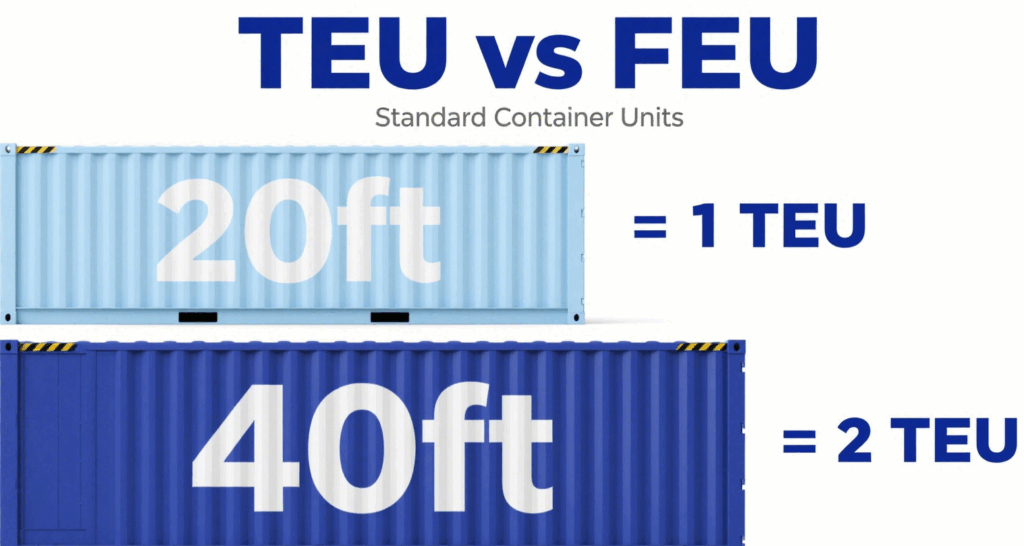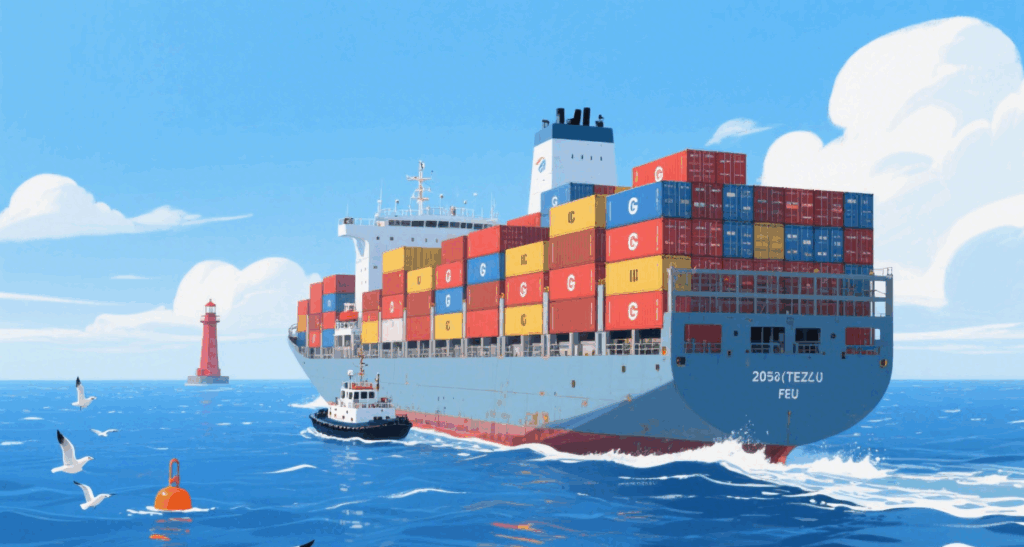Shipping and global trade rely on standards that allow companies, ports, and carriers to communicate clearly. One of the most widely used measurements in container transport is the TEU. But what is it exactly, and why is it so important?
Whether you’re new to logistics, managing imports, or just curious about how goods move across oceans, this guide breaks it all down in simple terms.
1. What Does TEU Stand For?
TEU stands for Twenty-foot Equivalent Unit. It refers to the cargo capacity of a standard 20-foot shipping container. This unit of measurement is the international benchmark used to calculate container volume and vessel or terminal capacity.
1 TEU = 20 ft container (approx. 6.06 m x 2.44 m x 2.59 m)
Even larger containers (like 40 ft) are measured in TEUs:
- 40 ft container = 2 TEUs
- 45 ft container ≈ 2.25 TEUs

2. Standard Container Dimensions
Here are the typical measurements for one standard 20-foot unit:
| Specification | Metric | Imperial |
|---|---|---|
| Length | 6.06 meters | 19.9 feet |
| Width | 2.44 meters | 8 feet |
| Height | 2.59 meters | 8.5 feet |
| Internal Volume | ~33 cubic meters | ~1,170 cubic feet |
| Max Gross Weight | ~24,000 kg | ~52,900 lbs |
Even though there are containers with different heights or capacities, they are still measured in the same unit for simplicity.
3. How It’s Used in Shipping
This standardized unit plays a crucial role in container logistics:
- Shipping lines use it to describe vessel capacity
- Ports track how many containers they process using this metric
- Freight companies quote prices based on it
- Shippers estimate space requirements for exporting goods
In short, the TEU is everywhere in maritime trade. It’s the common language of container shipping.
4. Ship Classification by Capacity
Container vessels are classified based on how many units they can carry:
| Ship Type | Capacity (in TEUs) |
|---|---|
| Feeder | < 3,000 |
| Panamax | 3,000–5,100 |
| Post-Panamax | 5,100–10,000 |
| New Panamax | 10,000–14,500 |
| Ultra-Large (ULCV) | 14,500+ |
Some of the world’s largest ships can carry over 24,000 containers measured in this unit.
5. Global Ports and Throughput
The busiest ports in the world use TEU counts to measure how much cargo they move. Here’s a quick look at some top performers:
| Port Name | Annual Volume (approx.) |
|---|---|
| Shanghai, China | 43.5 million |
| Singapore | 39 million |
| Ningbo-Zhoushan | 33 million |
| Rotterdam, NL | 15 million |
| Los Angeles, USA | 10 million |
These numbers help indicate a port’s efficiency and size.

6. TEU vs FEU: What's the Difference?
You might also hear the term FEU, which stands for Forty-foot Equivalent Unit. Here’s how they compare:
| Container Type | Unit Value |
|---|---|
| 20-foot | 1 TEU |
| 40-foot | 1 FEU = 2 TEU |
| 45-foot | ~2.25 TEU |
While both units are used in the industry, the 20-foot-based TEU remains the global standard for capacity planning.
7. Practical Example of TEU Use
Let’s say a company is shipping:
- 25 containers that are 40 feet each
- 10 containers that are 20 feet each
Total units = (25 × 2) + (10 × 1) = 60 TEU
This number is critical for determining how much ship space is needed and how to calculate freight charges.
8. Limitations
While this unit is very helpful, it isn’t perfect. Here’s why:
- It doesn’t reflect the exact weight of the cargo
- It doesn’t account for container height variations
- It’s not ideal for less-than-container-load (LCL) shipments
For those cases, shipping professionals often use CBM (Cubic Meters) or weight-based metrics.
9.Conclusion
To summarize:
- TEU stands for Twenty-foot Equivalent Unit
- It simplifies how we measure container capacity
- It applies across ports, ships, rail, and logistics companies
- It’s the foundation of modern container shipping
Whether you’re a beginner in logistics or a seasoned supply chain expert, understanding this unit is key to making smarter shipping decisions.
Request a Quote
Need a tailored solution for your shipping from China?
Let TJ China Freight Forwarder assist you with reliable, cost-effective service.
FAQ:
Q1.What is TEU in simple terms?
It’s a measurement unit based on the size of a 20-foot container, used to estimate shipping volume.
Q2.Why do ports use TEU to report traffic?
Because it gives a consistent standard to compare operations across global terminals.
Q3.Do high cube containers count as more than 1 TEU?
No. Even if they are taller, they still count as 1 TEU if they are 20 feet in length.
Q4.Can TEU be used for trucking or rail?
Yes. It’s also used in intermodal transport, where containers are moved by trucks or trains.
Q5.Is this unit used in air freight?
No. Air cargo typically uses weight and volume measurements like kilograms or cubic meters, not TEU.
